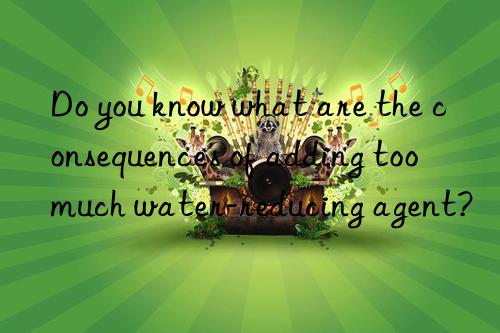
There are many types of water-reducing agents. The components of various types of water-reducing agents have different effects, and the consequences of excessive amounts will also be different. Concrete mixtures mixed with water-reducing agents will have problems such as pot sticking, false setting, non-setting, excessive slump loss, or low strength after hardening. The following are the causes and solutions to the above problems. What are the consequences of adding too much water-reducing agent? The editor of the water-reducing agent manufacturer will let you know.
If it is a simple water-reducing agent without retardation, air entrainment and other components, that is to say, a water-reducing agent with only water-reducing function, excessive amount will only cause excessive concrete slump. , or segregation, bleeding, hardening, etc.
However, many types of water-reducing admixtures have retarding and air-entraining functions. For example, most of the water-reducing admixtures used in mixing stations and construction sites have other functions such as retarding and air-entraining. When he designed Just consider using the normal dosage, retarding the setting for a few hours, and the gas content. Normal dosage or a little more than that will not slow the setting or cause the air to exceed the standard. But if there is too much, (general admixture factories will have a recommendation Dosage range), excessive retardation and excessive air content will cause the concrete to set too slowly, and high air content will lead to a reduction in the strength of the concrete.
Specifically, you can ask the admixture manufacturer to see how much excess will not cause problems.
The main thing is that the condensation time and gas content should not exceed the standards.
When I prepare a water-reducing agent, I usually consider the measurement error. It is probably not a big problem if I mix it 1.5 times, but it is hard to say if it is doubled. Generally speaking, if each truck is loaded with 10 cubic meters and the admixture is 6 kilograms per cubic meter, for a total of 60 kilograms, since the concrete is dry, it is not a big problem if you add ten to twenty kilograms of water-reducing agent, but you must turn a few times quickly. Stir evenly for a few minutes and then unload. As long as the amount of additives is not seriously exceeded, it is better than adding water. Adding water will definitely not be enough. Our mixing stations generally add admixtures or return them to the factory for downgrading.
If too much water-reducing agent is added to concrete, excessive slump and stone segregation will occur.
Water reducing agent is a concrete admixture that can reduce the amount of mixing water while maintaining the slump of concrete. Most of them are anionic surfactants, including lignin sulfonate, naphthalene sulfonate formaldehyde polymer, etc. After being added to the concrete mixture, it has a dispersing effect on the cement particles, which can improve its workability, reduce the unit water consumption, and improve the fluidity of the concrete mixture; or reduce the unit cement consumption and save cement.
According to the water-reducing and enhancing capabilities of water-reducing agents, they are divided into ordinary water-reducing agents (also known as plasticizers, the water-reducing rate is not less than 8%, represented by lignosulfonates), high-efficiency water-reducing agents Water-reducing agents (also known as superplasticizers, the water-reducing rate is not less than 14%, including naphthalene series, melamine series, sulfamate series, aliphatic series, etc.) and high-performance water-reducing agents (the water-reducing rate is not less than 14%) 25%, represented by polycarboxylic acid superplasticizer), and are divided into early strength type, standard type and retardant type.
</p

 微信扫一扫打赏
微信扫一扫打赏

